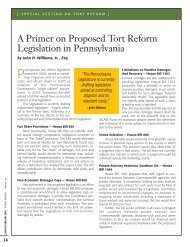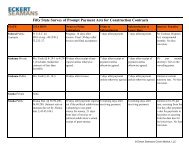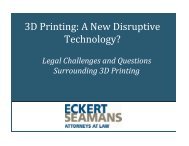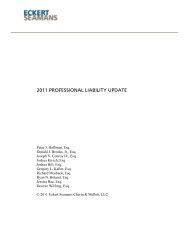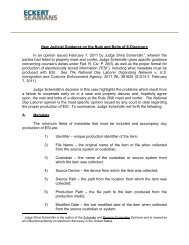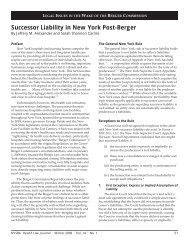The court found, however, to state a claim the third-party beneficiary must be named inthe will the attorney drafted. The court rejected the plaintiffs’ argument that they shouldbe accorded third-party beneficiary status because the defendant’s failure to draft a willwhich accurately represented their step grandmother’s intent deprived the plaintiffs oftheir bequest, which was contained in an earlier will. The court reasoned the decedentcontracted with the defendant to draft her later will and the fact the plaintiffs werementioned in an earlier will did not accord them third-party beneficiary status.H. Waiver of Meritorious DefenseIn Ammon v. McCloskey, 655 A.2d 549 (Pa. Super. Ct. 1995), appeal denied, 670 A.2d139 (Pa. 1995), the court ruled that waiver of a viable release defense, resulting in the entry of ajudgment against the client, constituted a viable cause of action for legal malpractice whichmight subject the attorney to damages for the underlying judgment. However, the court furtherstated that the issue of whether a waiver had actually occurred had never been fully litigatedagainst the lawyer, and therefore remained a valid factual question to be resolved in litigation ofthe legal malpractice case. Id. at 553-54.I. Duty to Keep Client InformedIn Perkovic v. Barrett, 671 A.2d 740 (Pa. Super. Ct. 1996), Plaintiffs sued their attorneyfor legal malpractice based on the following fee agreement:CLIENTS expressly retain Attorney [***] for the handling of theappeal of this matter to Superior Court which has been timelyfiled; ATTORNEY is to prepare and prosecute said appeal in adiligent and professional manner;CLIENTS agree to pay ATTORNEY the sum of $15,000 toprepare and prosecute this appeal; this includes the preparation andfiling of the proper notices of appeal, preparation, legal researchand legal writing necessary for the Legal Brief. . . ATTORNEYagrees to represent CLIENTS at any oral argument that may benecessitated by the Superior Court in the perfecting of this appeal.The court held that this fee agreement required Defendant-attorney to notify the client ofthe results of the appeal. The court also held, however, that the fee agreement did not imposeupon Defendant-attorney a duty to continue representation following the remand of the case as itonly contemplated the appeal referenced therein. Id. at 744.J. Statute of LimitationsA legal malpractice action founded upon negligence is subject to the two-year statute oflimitations while such an action founded upon breach of contract is subject to the four-yearstatute of limitations. See, e.g., Fiorentino v. Rapoport, 693 A.2d 208 (Pa. Super. Ct. 1997),appeal denied, 701 A.2d 577 (Pa. 1997). It should also be noted, that the courts have rejectedattempts to “[r]e-package a negligence-based malpractice claim under an [contract] theory toavoid the statute of limitations.” The court, citing Sherman Industries, Inc. v. Goldhammer, 683158
F. Supp. 502 (E.D. Pa. 1988), explained, “[a] malpractice plaintiff may not sidestep the two-yearlimitation on tort actions by pleading tort claims as breaches of contract.” Id.The Pennsylvania Supreme Court recently held in Steiner v. Markel, 968 A.2d 1253(2009), that Plaintiffs had waived their right to argue that their professional malpractice claimshould be construed as a contract claim, in order to avoid the two-year limitation, when theirComplaint did not contain a claim described as a breach of contract claim. Additionally, theCourt held that the Superior Court may not sua sponte, search within a complaint to find a causeof action that Plaintiffs never argued was present in their complaint. Id.Under Pennsylvania law, the occurrence rule is used to determine when the statute oflimitations begins to run. Fiorentino, 693 A.2d at 208. Under this rule, “the statutory periodcommences when the harm is suffered, or if appropriate, at the time an alleged malpractice isdiscovered.” Id.; see also Deere & Co. v. Reinhold, No. 99-CV-6313, 2000 U.S. Dist. LEXIS5276 (E.D. Pa. Apr. 24, 2000) (a cause of action for legal malpractice accrues on the date theharm is suffered and not on the date that the attorney-client relationship ends); TowerInvestments, Inc. v. Rawle & Henderson, LLP, 2009 Phila Ct. Com. Pl. LEXIS 18 (Phila. Cty.Ct. Com. Pl. Apr. 7, 2009) (holding “[t]he statute of limitations in legal malpractice actionsbegins upon the happening of an alleged breach of duty and is tolled only when the client,despite the exercise of due diligence, cannot discover the injury or its cause”).To date, Pennsylvania courts have expressly rejected the “continuing representationexception” under which a claim for malpractice accrues upon termination of the professionalrelationship which gave rise to the alleged malpractice. See, e.g., Glenbrook Leasing Co. v.Beausang, 839 A.2d 437, 441-42 (Pa. Super. Ct. 2003), appeal granted, 870 A.2d 318 (Pa. 2005),aff’d, 881 A.2d 1266 (Pa. 2005); see also Ward v. Knox McLaughlin Gornall & Sennett, No. 09-68, 2009 U.S. Dist. LEXIS 86058 (W.D. Pa. Sept. 21, 2009) (citing Glenbrook, court refused toapply “continuous representation rule”). It is noteworthy, however, that after the SuperiorCourt’s discussion of the continuous representation rule in Glenbrook, and acknowledgmentthere that adoption of this rule would have to come from the Supreme Court, the PennsylvaniaSupreme Court has granted an appeal in this case limited to the issue of “[w]hether thecontinuous representation rule should be adopted in Pennsylvania to toll the applicable statute oflimitations in an action for legal malpractice.” Glenbrook Leasing Co. v. Beausang, 870 A.2d318 (Pa. 2005). Without issuing a written opinion, the Supreme Court affirmed the SuperiorCourt’s decision. Glenbrook Leasing Co. v. Beausang, 881 A.2d 1266 (Pa. 2005).If the discovery rule applies, the statutory period commences at the time the allegedmalpractice is discovered. Davis v. Grimaldi, Haley & Frangiosa, P.C., No. 97-CV-4816, 1998U.S. Dist. LEXIS 15681 (Pa. Super. Ct. 1998) (citing Bailey v. Tucker, 621 A.2d 108, 115 (Pa.1993)). The discovery rule “provides that where the existence of the injury is not known to thecomplaining party and such knowledge cannot reasonably be ascertained within the prescribedstatutory period, the limitations period does not begin to run until the discovery of the injury isreasonably possible.” Id. at 4-5 (citing Dalrymple v. Brown, 701 A.2d 164, 167 (Pa. 1997)).The Dalrymple Court discussed the standard for the application of the discovery rule:The party seeking to invoke the discovery rule bears the burden ofestablishing the inability to know of the injury despite the exercise159
- Page 3 and 4:
EMTALA CASES ......................
- Page 5:
Filing an Affidavit of Non-Involvem
- Page 8 and 9:
II.PROFESSIONAL LIABILITY - AN OVER
- Page 10 and 11:
The Superior Court reversed the tri
- Page 12 and 13:
to a third party pursuant to the st
- Page 14 and 15:
After approximately five months, De
- Page 16 and 17:
learned the day after the surgery t
- Page 18 and 19:
conduct to the delay in colon cance
- Page 20 and 21:
court admitted the expert’s testi
- Page 22 and 23:
(b)(c)other reasonable causes, incl
- Page 24 and 25:
corroborated his testimony. The cou
- Page 26 and 27:
husband’s estate. Plaintiff alleg
- Page 28 and 29:
Other notable federal cases arising
- Page 30 and 31:
The Superior Court found that in re
- Page 32 and 33:
§ 1303.512(b). The court, however,
- Page 34 and 35:
In Neidig v. United States, No. 07-
- Page 36 and 37:
Additionally, the Supreme Court not
- Page 38 and 39:
were not indicated for her conditio
- Page 40 and 41:
surgeon is the same as it would be
- Page 42 and 43:
It should be noted that the Superio
- Page 44 and 45:
Finally, the court held that the tr
- Page 46 and 47:
The Supreme Court of Pennsylvania r
- Page 48 and 49:
nurses deviating from applicable st
- Page 50 and 51:
certainty, the court reviews expert
- Page 52 and 53:
Under Pennsylvania law, the Court n
- Page 54 and 55:
testimony, Defendant presented his
- Page 56 and 57:
Following Cooper v. Roberts, 286 A.
- Page 58 and 59:
Plaintiff developed chronic diarrhe
- Page 60 and 61:
where payment is made by Medicaid w
- Page 62 and 63:
accomplished. In Valles v. Albert E
- Page 64 and 65:
In 1980, the Pennsylvania Superior
- Page 66 and 67:
Plaintiff had a routine monitoring
- Page 68 and 69:
Plaintiff’s Contract ClaimsThe Co
- Page 70 and 71:
is a failure to report changes in a
- Page 72 and 73:
unit to assure post-surgical patien
- Page 74 and 75:
sliced his wrist and arm with a raz
- Page 76 and 77:
licensed professionals for whom the
- Page 78 and 79:
(c)Limitations of Corporate Neglige
- Page 80 and 81:
Even more recently, our Superior Co
- Page 82 and 83:
(a)HMO IssuesIn McClellan v. Health
- Page 84 and 85:
affidavit submitted by Defendants o
- Page 86 and 87:
treatments while at VA’s faciliti
- Page 88 and 89:
[s]ubstantively, we believe that a
- Page 90 and 91:
The party claiming the benefit of t
- Page 92 and 93:
deprive (him) of civil rights guara
- Page 94 and 95:
found that the District Court was w
- Page 96 and 97:
With respect to fraudulent concealm
- Page 98 and 99:
would be applied in situations wher
- Page 100 and 101:
they had not raised them in the cou
- Page 102 and 103:
(a)Informed ConsentUnder MCARE, a p
- Page 104 and 105:
civil enforcement provisions and ma
- Page 106 and 107:
MCARE also changes the manner in wh
- Page 108 and 109:
whose death, in 2005, was allegedly
- Page 110 and 111:
vicariously liable if the plaintiff
- Page 112 and 113:
health center or its equivalent or
- Page 114 and 115: In Pennsylvania Medical Society, th
- Page 116 and 117: to any professional who is alleged
- Page 118 and 119: Since the 2005 amendments, there ha
- Page 120 and 121: ule, but who intentionally ignores
- Page 122 and 123: the original Complaint was delivere
- Page 124 and 125: foreclose all challenges against th
- Page 126 and 127: number of boxes), which was support
- Page 128 and 129: questions of professional judgment
- Page 130 and 131: deviated from any professional stan
- Page 132 and 133: The Third Circuit affirmed the Dist
- Page 134 and 135: claims and cross-claims remain agai
- Page 136 and 137: By an Amendatory Order dated March
- Page 138 and 139: The court acknowledged that there i
- Page 140 and 141: apply and that the trial court misa
- Page 142 and 143: Barbados had enough litigation-spec
- Page 144 and 145: E. Preemption of Vaccine Design Def
- Page 146 and 147: 2. Pa. R. Civ. Pro. 1036.1 - Reinst
- Page 148 and 149: Barrick, at *34-35.Furthermore, the
- Page 150 and 151: (b) the utility of the defendant’
- Page 152 and 153: 2006). In this case, Plaintiffs bro
- Page 154 and 155: B. Elements of a Cause of Action fo
- Page 156 and 157: decision in Muhammad precluded Mr.
- Page 158 and 159: considered speculative “only if t
- Page 160 and 161: underlying cause of action involved
- Page 162 and 163: In Capital Care Corp., the Superior
- Page 166 and 167: of reasonable diligence. The standa
- Page 168 and 169: not be set aside. On July 7, 2005,
- Page 170 and 171: complete bar to recovery. Since a l
- Page 172 and 173: On appeal, Plaintiffs claimed that
- Page 174 and 175: In Liggon-Redding, 659 F.3d at 265,
- Page 176 and 177: elieved of those minimum standards
- Page 178 and 179: elevant to the proceedings, the com
- Page 180 and 181: establish professional misconduct b
- Page 182 and 183: Upholding the Superior Court’s Or
- Page 184 and 185: Id.Rejecting revocation and suspens
- Page 186 and 187: order as a sanction under Rule 4019
- Page 188: {1009912]182




